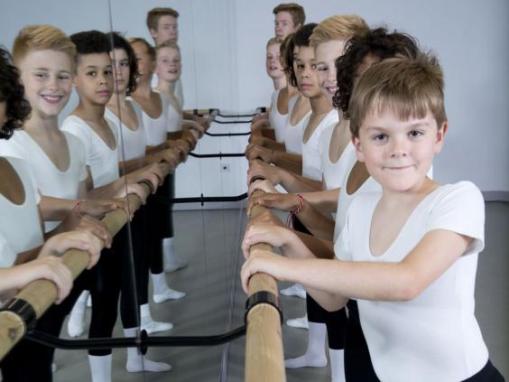By Steve Trounday
Reno Gazette-Journal
December 4, 2015
[Reno, Nevada, USA] – One of the stereotypes of ballet is that it’s a girl’s activity. Often when one thinks of a ballet dancer, a woman wearing a tutu and pirouetting with her pointe shoes is the first thing that pops into your head. The concept of a male ballet dancer is not top of mind — especially in the United States. Yet some of the most famous ballet dancers of all time are men. With their powerful leaps, dancers Mikhail Baryshnikov and Rudolf Nureyev are arguably the two most well-known dancers in modern ballet.
There has been a stigma in the U.S. that has kept American boys away from ballet. It’s kind of ironic because when you watch a professional ballet dancer, both male and female, the athleticism is as rigorous as in any sport. And I mean any sport. The leg strength needed to make those commanding leaps and the upper body strength required for partnering and lifting a ballerina into the air is substantial. What they make look so easy is tremendously difficult to do.
The lack of male dancers from the U.S. means a majority of male dancers in American ballet companies come from other countries. There have been periods of time where all of the male dancers in the San Francisco Ballet have been from countries outside of the United States.
Perhaps this is beginning to change. The success of the stage play and the movie “Billy Elliot,” the popularity of the television show “So You Think You Can Dance,” and the growing approval of ballet in general are adding an element of cool to the art form.
Proof of this can be found with the Tilton brothers, originally from San Marco, California. All four brothers (Roy, Rex, Raymond and Ronald) have danced with professional ballet companies at some point in their lives. Rex is a principal dancer with Utah’s Ballet West. His brother Ronald is a corps artist with the same company. Both men have performed in A.V.A. Ballet Theatre productions here in Reno. Rex starred as the prince in “Swan Lake” and as a featured dancer in the rock ballet “Vortex.” Ronald was a featured dancer in “Vortex” for two consecutive years. Both Rex and Ronald were stars in the CW television reality series “Breaking Pointe.”
Raymond Tilton has danced with the San Francisco Ballet and is currently with the Diablo Ballet. Raymond will be making his debut with A.V.A. Ballet Theatre next week in “The Nutcracker” at the Pioneer Center for the Performing Arts. He will star as the Sugar Plum Cavalier.
I asked Raymond how the four brothers became involved with ballet. “Our sisters were taking ballet lessons,” he said of his older sister Alexis and twin younger sisters Angelica and Abigale. “My brothers and I were outside of their ballet studio just goofing around. The director of the studio — needing male dancers for his performances — came out and offered us free dance lessons.” At the time, none of the brothers expected that ballet would become such a large part of their lives. Their passion had been soccer. They each began attending more advanced ballet schools and honing their skills.
While the oldest brother Roy has moved on to other pursuits, Rex, Ronald and Raymond continue to excel in the profession. Their dark hair and handsome brooding features combined with their dancing ability make them popular performers.
Alexander Van Alstyne, the artistic director of A.V.A. Ballet Theatre, appreciates their dance ability. Van Alstyne was a professional dancer with Ballet West, the Boston Ballet, and the San Francisco Ballet. “It’s exciting for the art of ballet to see so many male dancers,” he said. It’s even more amazing to see so much talent in one family.”
Raymond is looking forward to his Sugar Plum Cavalier role next week in “The Nutcracker.” He said, “My brothers have always told me how much fun they have when they come to Reno to dance for Alex. I’m really looking forward to the experience.”
Joining Raymond in the production will be local male dancer David Huffmire. David has danced with A.V.A. Ballet Theatre since he was a child and is currently a trainee with Ballet West. David was so eager to begin professional dancing in Utah that he graduated early from Galena High School to make this happen. Like the Tilton brothers, David knows it’s cool to be a ballet dancer.
Steve Trounday is a board member at A.V.A. Ballet Theatre, the resident ballet company of the Pioneer Center.
© 2016 http://www.rgj.com.
Related Article: A Few Good Men
















